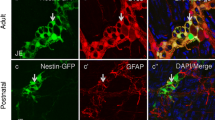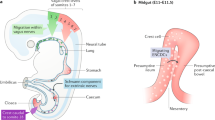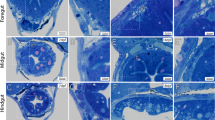Abstract
The largest part of the peripheral nervous system is the enteric nervous system (ENS). It consists of an intricate network of several enteric neuronal subclasses with distinct phenotypes and functions within the gut wall. The generation of these enteric phenotypes is dependent upon appropriate neurotrophic support during development. Glial cell line-derived neurotrophic factor (GDNF) and fibroblast growth factor-2 (FGF2) play an important role in the differentiation and function of the ENS. A lack of GDNF or its receptor (Ret) causes intestinal aganglionosis in mice, while fibroblast growth factor receptor signaling antagonist is identified as regulating proteins in the GDNF/Ret signaling in the developing ENS. Primary myenteric plexus cultures and wholemount preparations of wild type (WT) and FGF2-knockout mice were used to analyze distinct enteric subpopulations. Fractal dimension (D) as a measure of self-similarity is an excellent tool to analyze complex geometric shape and was applied to classify the subclasses of enteric neurons concerning their individual morphology. As a consequence of a detailed analysis of subpopulation variations, wholemount preparations were stained for the calcium binding proteins calbindin and calretinin. The fractal analysis showed a reliable consistence of subgroups with different fractal dimensions (D) in each culture investigated. Seven different neuronal subtypes could be differentiated according to a rising D. Within the same D, the neurite length revealed significant differences between wild type and FGF2-knockout cultures, while the subclass distribution was also altered. Depending on the morphological characteristics, the reduced subgroup was supposed to be a secretomotor neuronal type, which could be confirmed by calbindin and calretinin staining of the wholemount preparations. These revealed a reduction up to 40 % of calbindin-positive neurons in the FGF2-knockout mouse. We therefore consider FGF2 playing a more important role in the fine-tuning of the ENS during development as previously assumed.




Similar content being viewed by others
References
Acosta CG, Fabrega AR, Masco DH, Lopez HS (2001) A sensory neuron subpopulation with unique sequential survival dependence on nerve growth factor and basic fibroblast growth factor during development. J Neurosci 21(22):8873–8885
Borghini S, Duca MD, Pini Prato A, Lerone M, Martucciello G, Jasonni V, Ravazzolo R, Ceccherini I (2009) Search for pathogenetic variants of the SPRY2 gene in intestinal innervation defects. Intern Med J 39(5):335–337. doi:10.1111/j.1445-5994.2009.01907.x
Brehmer A (2006) Structure of enteric neurons. Adv Anat Embryol Cell Biol 186:1–91
Brehmer A, Schrodl F, Neuhuber W (1999a) Morphological classifications of enteric neurons—100 years after Dogiel. Anat Embryol (Berl) 200(2):125–135
Brehmer A, Schrodl F, Neuhuber W, Hens J, Timmermans JP (1999b) Comparison of enteric neuronal morphology as demonstrated by Dil-tracing under different tissue-handling conditions. Anat Embryol (Berl) 199(1):57–62
Brehmer A, Croner R, Dimmler A, Papadopoulos T, Schrodl F, Neuhuber W (2004) Immunohistochemical characterization of putative primary afferent (sensory) myenteric neurons in human small intestine. Auton Neurosci 112(1–2):49–59. doi:10.1016/j.autneu.2004.03.005
Brehmer A, Lindig TM, Schrodl F, Neuhuber W, Ditterich D, Rexer M, Rupprecht H (2005) Morphology of enkephalin-immunoreactive myenteric neurons in the human gut. Histochem Cell Biol 123(2):131–138. doi:10.1007/s00418-005-0757-6
Clarke CM, Plata C, Cole B, Tsuchiya K, La Spada AR, Kapur RP (2007) Visceral neuropathy and intestinal pseudo-obstruction in a murine model of a nuclear inclusion disease. Gastroenterology 133(6):1971–1978. doi:10.1053/j.gastro.2007.08.043
Cornish EE, Natoli RC, Hendrickson A, Provis JM (2004) Differential distribution of fibroblast growth factor receptors (FGFRs) on foveal cones: FGFR-4 is an early marker of cone photoreceptors. Mol Vis 10:1–14
Dogiel AS (1895) Zur Frage über die Ganglion der Darmgeflechte bei den Säugetieren. Anat Anz 10:517–528
Dono R, Texido G, Dussel R, Ehmke H, Zeller R (1998) Impaired cerebral cortex development and blood pressure regulation in FGF-2-deficient mice. EMBO J 17(15):4213–4225. doi:10.1093/emboj/17.15.4213
Furness J (2006) The enteric nervous system. Blackwell, Oxford
Furness JB, Keast JR, Pompolo S, Bornstein JC, Costa M, Emson PC, Lawson DE (1988) Immunohistochemical evidence for the presence of calcium-binding proteins in enteric neurons. Cell Tissue Res 252(1):79–87
Furness JB, Trussell DC, Pompolo S, Bornstein JC, Smith TK (1990) Calbindin neurons of the guinea-pig small intestine: quantitative analysis of their numbers and projections. Cell Tissue Res 260(2):261–272
Furness JB, Jones C, Nurgali K, Clerc N (2004a) Intrinsic primary afferent neurons and nerve circuits within the intestine. Prog Neurobiol 72(2):143–164. doi:10.1016/j.pneurobio.2003.12.004
Furness JB, Robbins HL, Xiao J, Stebbing MJ, Nurgali K (2004b) Projections and chemistry of Dogiel type II neurons in the mouse colon. Cell Tissue Res 317(1):1–12. doi:10.1007/s00441-004-0895-5
Gershon M (1998) The second brain. Haper Collins, New York
Hagl CI, Holland-Cunz S, Schäfer KH (2003) What do knockout models teach us about the enteric nervous system? Eur J Pediatr Surg 13(3):170–175. doi:10.1055/s-2003-41267
Hagl CI, Klotz M, Wink E, Kranzle K, Holland-Cunz S, Gretz N, Diener M, Schäfer KH (2008) Temporal and regional morphological differences as a consequence of FGF-2 deficiency are mirrored in the myenteric proteome. Pediatr Surg Int 24(1):49–60. doi:10.1007/s00383-007-2041-4
Hanani M, Reichenbach A (1994) Morphology of horseradish peroxidase (HRP)-injected glial cells in the myenteric plexus of the guinea-pig. Cell Tissue Res 278(1):153–160
Iwata T, Hevner RF (2009) Fibroblast growth factor signaling in development of the cerebral cortex. Dev Growth Differ 51(3):299–323. doi:10.1111/j.1440-169X.2009.01104.x
La Rosa S, Uccella S, Erba S, Capella C, Sessa F (2001) Immunohistochemical detection of fibroblast growth factor receptors in normal endocrine cells and related tumors of the digestive system. Applied immunohistochemistry & molecular morphology : AIMM/official publication of the Society for Applied Immunohistochemistry 9(4):319–328
Lammers WJ, Cheng LK (2008) Simulation and analysis of spatio-temporal maps of gastrointestinal motility. Biomed Eng Online 7:2. doi:10.1186/1475-925x-7-2
Lister T, Tam P (1990) Hirschsprungs disease. Neonatal surgery. Butterworths, London
Mandelbrot BB (1982) Fractals and the geometry of nature. Freeman, New York
Mandelbrot BB (1985) Fractals and the geometry of nature. San Francisco
Mao Y, Wang B, Kunze W (2006) Characterization of myenteric sensory neurons in the mouse small intestine. J Neurophysiol 96(3):998–1010. doi:10.1152/jn.00204.2006
Mason I (2007) Initiation to end point: the multiple roles of fibroblast growth factors in neural development. Nat Rev Neurosci 8(8):583–596. doi:10.1038/nrn2189
Mazzuoli G, Schemann M (2009) Multifunctional rapidly adapting mechanosensitive enteric neurons (RAMEN) in the myenteric plexus of the guinea pig ileum. J Physiol 587(Pt 19):4681–4694. doi:10.1113/jphysiol.2009.177105
Meier-Ruge WA, Ammann K, Bruder E, Holschneider AM, Scharli AF, Schmittenbecher PP, Stoss F (2004) Updated results on intestinal neuronal dysplasia (IND B). Eur J Pediatr Surg 14(6):384–391. doi:10.1055/s-2004-821120
Miyamoto R, Jijiwa M, Asai M, Kawai K, Ishida-Takagishi M, Mii S, Asai N, Enomoto A, Murakumo Y, Yoshimura A, Takahashi M (2010) Loss of Sprouty2 partially rescues renal hypoplasia and stomach hypoganglionosis but not intestinal aganglionosis in Ret Y1062F mutant mice. Dev Biol. doi:10.1016/j.ydbio.2010.11.002
Molski M, Konarski J (2006) Neuronal differentiation and synapse formation in the space-time with temporal fractal dimension. Synapse 60(8):567–572. doi:10.1002/syn.20333
Mongardi Fantaguzzi C, Thacker M, Chiocchetti R, Furness JB (2009) Identification of neuron types in the submucosal ganglia of the mouse ileum. Cell Tissue Res 336(2):179–189. doi:10.1007/s00441-009-0773-2
Mwizerwa O, Das P, Nagy N, Akbareian SE, Mably JD, Goldstein AM (2011) Gdnf is mitogenic, neurotrophic, and chemoattractive to enteric neural crest cells in the embryonic colon. Dev Dyn 240(6):1402–1411. doi:10.1002/dvdy.22630
Nasser Y, Ho W, Sharkey KA (2006) Distribution of adrenergic receptors in the enteric nervous system of the guinea pig, mouse, and rat. J Comp Neurol 495(5):529–553. doi:10.1002/cne.20898
Newgreen D, Young HM (2002) Enteric nervous system: development and developmental disturbances—part 1. Pediatr Dev Pathol 5(3):224–247. doi:10.1007/s10024001-0142-y
Nurgali K, Stebbing MJ, Furness JB (2004) Correlation of electrophysiological and morphological characteristics of enteric neurons in the mouse colon. J Comp Neurol 468(1):112–124. doi:10.1002/cne.10948
O’Grady G, Du P, Lammers WJ, Egbuji JU, Mithraratne P, Chen JD, Cheng LK, Windsor JA, Pullan AJ (2010) High-resolution entrainment mapping of gastric pacing: a new analytical tool. Am J Physiol Gastrointest Liver Physiol 298(2):G314–G321. doi:10.1152/ajpgi.00389.2009
Qu ZD, Thacker M, Castelucci P, Bagyanszki M, Epstein ML, Furness JB (2008) Immunohistochemical analysis of neuron types in the mouse small intestine. Cell Tissue Res 334(2):147–161. doi:10.1007/s00441-008-0684-7
Raballo R, Rhee J, Lyn-Cook R, Leckman JF, Schwartz ML, Vaccarino FM (2000) Basic fibroblast growth factor (FGF2) is necessary for cell proliferation and neurogenesis in the developing cerebral cortex. J Neurosci 20(13):5012–5023
Reichenbach A, Siegel A, Senitz D, Smith TG Jr (1992) A comparative fractal analysis of various mammalian astroglial cell types. Neuroimage 1(1):69–77
Reid S, Ferretti P (2003) Differential expression of fibroblast growth factor receptors in the developing murine choroid plexus. Brain Res Dev Brain Res 141(1–2):15–24
Reuss B, von Bohlen und Halbach O (2003) Fibroblast growth factors and their receptors in the central nervous system. Cell Tissue Res 313(2):139–157. doi:10.1007/s00441-003-0756-7
Roberts RR, Bornstein JC, Bergner AJ, Young HM (2008) Disturbances of colonic motility in mouse models of Hirschsprung’s disease. Am J Physiol Gastr L 294(4):G996–G1008. doi:10.1152/Ajpgi.00558.2007
Schäfer KH, Saffrey MJ, Burnstock G (1995) Trophic actions of 2-chloroadenosine and bFGF on cultured myenteric neurones. Neuroreport 6(6):937–941
Schäfer KH, Saffrey MJ, Burnstock G, Mestres-Ventura P (1997) A new method for the isolation of myenteric plexus from the newborn rat gastrointestinal tract. Brain Res Brain Res Protoc 1(2):109–113
Schuchardt A, D’Agati V, Larsson-Blomberg L, Costantini F, Pachnis V (1994) Defects in the kidney and enteric nervous system of mice lacking the tyrosine kinase receptor Ret. Nature 367(6461):380–383. doi:10.1038/367380a0
Skaba R, Frantlova M, Horak J (2006) Intestinal neuronal dysplasia. Eur J Gastroenterol Hepatol 18(7):699–701. doi:10.1097/01.meg.0000224476.51428.7b
Smith TG Jr, Behar TN (1994) Comparative fractal analysis of cultured glia derived from optic nerve and brain demonstrate different rates of morphological differentiation. Brain Res 634(2):181–190
Smith TG Jr, Marks WB, Lange GD, Sheriff WH Jr, Neale EA (1989) A fractal analysis of cell images. J Neurosci Methods 27(2):173–180
Stach W (1981) The neuronal organization of the plexus myentericus (Auerbach) in the small intestine of the pig. II. Type II-neurone (author’s transl). Z Mikrosk Anat Forsch 95(2):161–182
Stach W, Krammer HJ, Brehmer A (2000) Structural organization of enteric nerve cells in large mammals including man. Neurogastroenterology from the basics to the clinics. Kluwer, Dordrecht
Taketomi T, Yoshiga D, Taniguchi K, Kobayashi T, Nonami A, Kato R, Sasaki M, Sasaki A, Ishibashi H, Moriyama M, Nakamura K, Nishimura J, Yoshimura A (2005) Loss of mammalian Sprouty2 leads to enteric neuronal hyperplasia and esophageal achalasia. Nat Neurosci 8(7):855–857. doi:10.1038/nn1485
Xue J, Askwith C, Javed NH, Cooke HJ (2007) Autonomic nervous system and secretion across the intestinal mucosal surface. Auton Neurosci 133(1):55–63. doi:10.1016/j.autneu.2007.02.001
Yoneda A, Wang Y, O’Briain DS, Puri P (2001) Cell-adhesion molecules and fibroblast growth factor signalling in Hirschsprung’s disease. Pediatr Surg Int 17(4):299–303
Young HM, Cane KN, Anderson CR (2011) Development of the autonomic nervous system: a comparative view. Auton Neurosci 165(1):10–27. doi:10.1016/j.autneu.2010.03.002
Zhang F, Clarke JD, Santos-Ruiz L, Ferretti P (2002) Differential regulation of fibroblast growth factor receptors in the regenerating amphibian spinal cord in vivo. Neuroscience 114(4):837–848
Zhou M, Sutliff RL, Paul RJ, Lorenz JN, Hoying JB, Haudenschild CC, Yin M, Coffin JD, Kong L, Kranias EG, Luo W, Boivin GP, Duffy JJ, Pawlowski SA, Doetschman T (1998) Fibroblast growth factor 2 control of vascular tone. Nat Med 4(2):201–207
Acknowledgments
This work is supported by the Landesförderung Baden-Württemberg. We thank Mrs. Anne Schuster and Mr. Markus Klotz for proof reading the manuscript.
Author information
Authors and Affiliations
Corresponding author
Rights and permissions
About this article
Cite this article
Hagl, C.I., Wink, E., Scherf, S. et al. FGF2 deficit during development leads to specific neuronal cell loss in the enteric nervous system. Histochem Cell Biol 139, 47–57 (2013). https://doi.org/10.1007/s00418-012-1023-3
Accepted:
Published:
Issue Date:
DOI: https://doi.org/10.1007/s00418-012-1023-3




